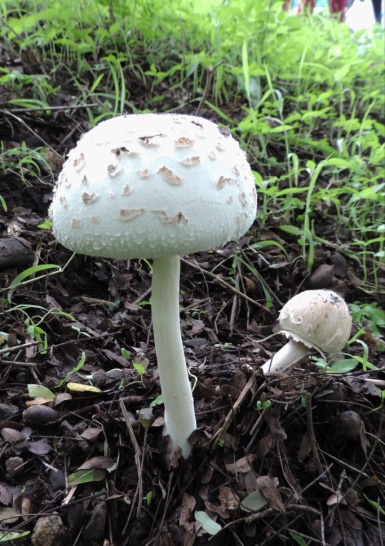Fruiting body medium to large. Pileus 5-11cm in diameter, ovoid at first, hemispheric when expanding, plano-convex at maturity, with a low, broad and obtuse umbo; surface dry, longitudinally striate; initially white, becoming cream; covered with brownish squamules, that are uplifted or flat and concentrated near the centre. Lamellae free, sub-crowded to crowded, white, becoming greenish when mature, brownish when dried; lamellulae attenuate, unevenly distributed, in 4 ranks. Stipe 4-12 x 0.7-1.5 cm, white, cylindrical to beige, easily detachable from pileus, widening towards the base, base slightly enlarged, finely fibrillose. Annulus well developed, membranous, upper surface whitish, lower surface brownish, double crowned. Odour and taste not distinctive. Basidiospores 9.4-11.7 x 6.3-8.3 µm, ellipsoid to elongate, thick-walled, smooth, light olive-green, dextrinoid, broad-truncate with wide germ pore. Spore-print dull greyish green. Basidia 20-24×9-10µm, clavate, hyaline, 4-spored. Pleurocystidia absent. Cheilocystidia 18-38×14-20µm, broadly clavate to sphaero-pedunculate, hyaline, thin-walled. Lamella trama irregular, made up of subcylindrical, hyaline hyphae, 8-13 μm in diameter.
Specimens examined
India, Maharashtra, Kolhapur, Kagal, Hamidwada (16°25ʹ32ʺN-74°16ʹ56ʺE), on soil, scattered, 07.07.2020, Bornak, S. I. (Y20V11C5); Karvir, Rajarshee Chhatrapati Shahu Maharaj College of Agriculture (16°41ʹ16ʺN-74°15ʹ36ʺE), on ground, alone, scattered, 13.07.2020, Bornak, S. I. (Y20V5C1); Karvir, Bondrenagar (16°40ʹ46ʺN-74°11ʹ26ʺE), on soil, in pair, 22.07.2020, Bornak, S. I. (Y20V12C1).
Remarks
Chlorophyllum molybdites is assigned to sect. Chlorophyllum, which is characterized by olive to greenish-white basidiospores with a truncate apex, broadly clavate to sphaero-pedunculate cheilocystidia and a palisade-like pileipellis of hyphae with terminal elements clavate to sub-fusiform (Ge, et al., 2018). The species has been reported from Karnataka, Kerala, Tamil Nadu and Uttar Pradesh (Senthilarasu and Kumaresan, 2016), Pune, Maharashtra (Sathe and Rahalkar, 1976; Sathe and Deshpande, 1980,1982), Kolhapur, Maharashtra (Patil and Thite, 1978); Amravati, Maharashtra (Hedawoo, 2010).
References:
Ge, Z. W., Jacobs, A., Vellinga, E. C., Sysouphanthong, P., van der Walt, R., Lavorato, C., An, Y. F., Yang, Z. L. (2018). A multi-gene phylogeny of Chlorophyllum (Agaricaceae, Basidiomycota): new species, new combination and infrageneric classification. MycoKeys, 20(32):65-90. doi: 10.3897/mycokeys.32.23831.
Senthilarasu, G. and Kumaresan, V. (2016). Diversity of Agaric mycota of Western Ghats of Karnataka, India. Current Research in Environmental & Applied Mycology 6(1):75–101, Doi 10.5943/cream/6/2/3
Sathe, A.V. and Rahalkar SR. (1976). Proceedings of Symposium on Survey and Cultivation of edible mushrooms in India, Reg. Research Laboratory, Srinagar, pp. 77-80.
Sathe, A.V. and Deshpande, S. (1980). Agaricales (Mushrooms) of Maharashtra State. In: Agaricales (Mushrooms) of South West India. MACS Monograph, 1:9-42.
Sathe, A.V. and Deshpande, S. (1982). Agaricales of Maharashtra. In: Advances in Mycology & Plant Pathology: Proceeding[s] of the National Symposium Held at Calcutta on 22nd, 23rd September, 1979, eds. S.B. Chattopadhyay & N. Samajpati, Oxford & IBH Publishing Company, pp. 81-88.
Patil, M.S., Thite, A.N. (1978). Fungal flora of Amboli (Ratnagiri). Journal of Shivaji University (Science), 18:219-224. Hedawoo, G.B. (2010). Wild mushroom flora from Amravati Region, Maharashtra, India. Journal of Mycology and Plant Pathology, 40(3:441-444.





